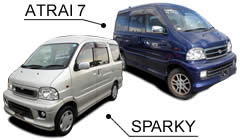What is the Difference Between the Toyota Sparky and the Daihatsu Atrai 7? - Vol.186
The Daihatsu Atrai 7 is a micro van that was developed by the Daihatsu Motor Company in 1999 as a spinoff of the Daihatsu Hijet. The vehicle was designed to be an export version of the Hijet, and featured larger bumpers and a wider body. In the 1967 Toyota became a majority shareholder in the Daihatsu Motor Company, and began marketing certain vehicles under separate names. In fact, the Atrai 7 was eventually marketed and sold as a Toyota Sparky.
The Atrai 7 was essentially a modification of the Hijet, and functioned as a 7 passenger van with a 1.3-liter engine. When compared to the Hijet the Atrai is nearly identical despite the slight modifications to the body of the vehicle.

A Long History
Although the Atrai 7 was not produced until the 1990's the vehicles predecessor has a long history. The Hijet began as a micro van and kei truck combination. The micro van and kei truck are Japanese creations that are classified by their assigned dimensions. As of 1998 the proportional standard set by law consists of a dimensional limit of 3.4X1.48X2 (meters), and a maximum displacement of 660cc.
These vehicles were used throughout Asia for various purposes ranging from farming, to construction, and even firefighting. These micro cars are street legal in Japan, but are only authorized to drive on local roads in the US.
The first Hijet was fitted with a 360cc two-stroke engine, as was mandated by the current kei car law, but would soon receive an upgrade as the 70's approached and the laws were revised. In 1976 Daihatsu released the Hijet 550. This model featured a 550cc AB20 engine, which increased the maximum payload by 50kg.
In 1981 Daihatsu released the brand new S65 Hijet, which included a version of the vehicle that was sold as the Hijet Atrai Van. This marked the entrance of the Atrai model into the Japanese market. The Hijet line was intended primarily for industrial and commercial use, while the Atrai was designed as a passenger van.
The second appearance of the Atrai line was the "Deck Van", also known as the Daihatsu Atrai Deck. Export versions of this vehicle were fitted with a much stronger engine that had a displacement of 993cc and featured three cylinders. However, due to the strict kei car laws the Atrai was limited to a much smaller displacement of 550cc while in Japan.
Overhaul
In 1999 Daihatsu made a strategic move and implemented separate designs for the van and truck models. During this time the kei trucks retained their standard design, but the van was completely overhauled. The newly implemented version consisted of a front engine semi cab design, which better conformed to the current crash safety standards of passenger vehicles.
The tenth, and current, generation known as the Hijet Cargo was the first van to conform to this new standard. In addition to the Cargo, Daihatsu introduced a 1.3-liter version called the Daihatsu Atrai 7, also known as the Toyota Sparky. This generation of vehicles was only offered as a van, while production of the ninth generation truck continued. The Atrai 7 is powered by a 660cc turbo engine, and comes in rear wheel and four wheel drives.
Pros and Cons
The Hijet has a long history of service, and has proven to be an extremely useful vehicle. The fact that the Hijet is offered as both a truck and a van makes this a particularly functional line that can meet the needs of various industries. However, the vehicle is limited by its size, and although the exported models are much stronger, they are limited even further by North American street regulations.